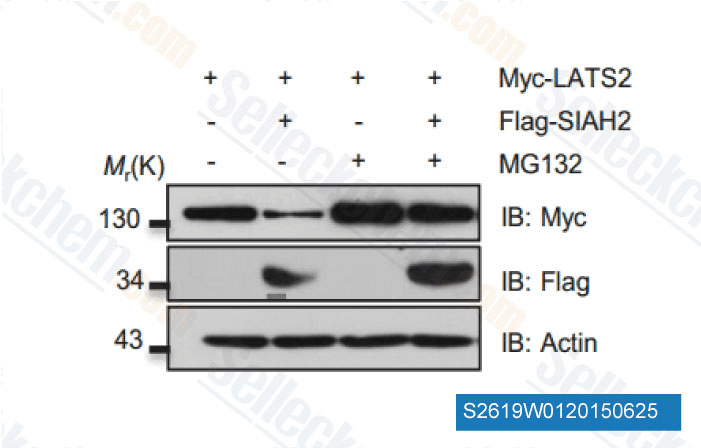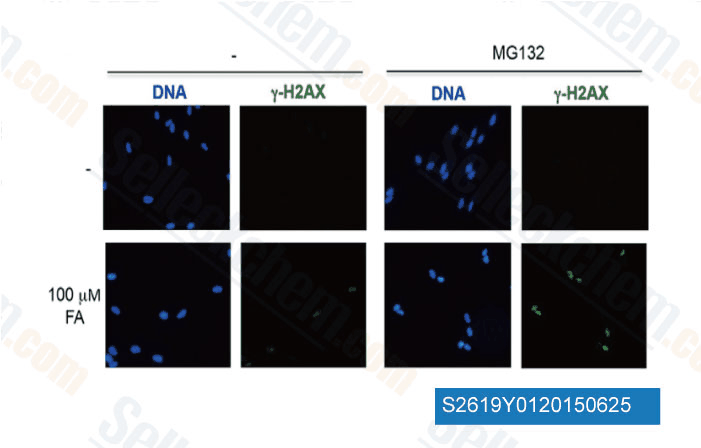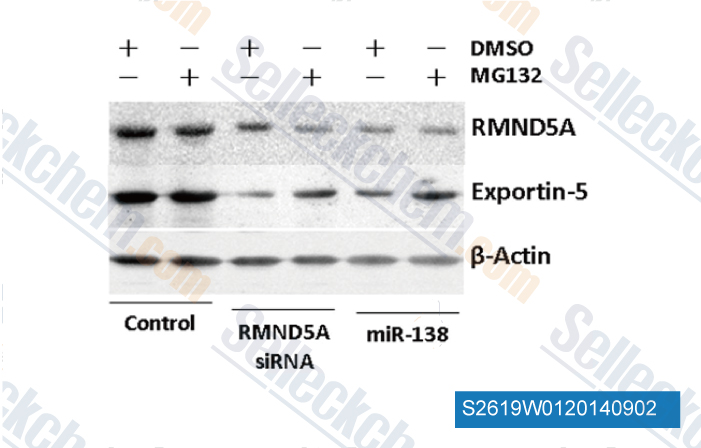|
Toll Free: (877) 796-6397 -- USA and Canada only -- |
Fax: +1-832-582-8590 Orders: +1-832-582-8158 |
Tech Support: +1-832-582-8158 Ext:3 Please provide your Order Number in the email. |
Technical Data
| Formula | C26H41N3O5 |
|||
| Molecular Weight | 475.62 | CAS No. | 1211877-36-9 | |
| Solubility (25°C)* | In vitro | DMSO | 95 mg/mL (199.73 mM) | |
| Ethanol | 95 mg/mL (199.73 mM) | |||
| Water | Insoluble | |||
|
* <1 mg/ml means slightly soluble or insoluble. * Please note that Selleck tests the solubility of all compounds in-house, and the actual solubility may differ slightly from published values. This is normal and is due to slight batch-to-batch variations. * Room temperature shipping (Stability testing shows this product can be shipped without any cooling measures.) |
||||
Preparing Stock Solutions
Biological Activity
| Description | MG132 ((S,R,S)-(-)-MG132, Z-Leu-D-Leu-Leu-al) is a potent proteasome (ChTL, TL, and PGPH) inhibitor. MG132 also inhibits calpain (IC50=1.2 μM). MG132 can be used to induce animal models of Parkinson’s disease. | ||
|---|---|---|---|
| Targets |
|
||
| In vitro | MG-132 displays >1000 times more activity than ZLLal in inhibiting the ZLLL-MCA-degrading activity of 20S proteasome with IC50 of 100 nM versus 110 μM. MG-132 also inhibits calpain with IC50 of 1.2 μM. MG-132 induces neurite outgrowth in PC12 cells at an optimal concentration of 20 nM, displaying 500 times more potency than ZLLal. [1] MG-132 (10 μM) potently inhibits TNF-α-induced NF-κB activation, interleukin-8 (IL-8) gene transcription, and IL-8 protein release in A549 cells by inhibition of proteasome-mediated IκBα degradation. [2] MG-132 treatment potently induces p53-dependent apoptosis in KIM-2 cells by 26S proteasome inhibition. [3] Unlike BzLLLCOCHO or PS-341, MG-132 treatment results in weak inhibition of the chymotrypsinlike (CT-L) and peptidylglutamyl peptide hydrolysing (PGPH) activities of the 26S proteasome, whereas multiple myeloma cells (U266 and OPM-2) are more sensitive to induction of apoptosis by MG-132 than BzLLLCOCHO. [4] MG-132 (1 μM) sensitizes TRAIL-resistant prostate cancer cells by activating the AP-1 family members c-Fos and c-Jun, which, in turn, repress the antiapoptotic molecule c-FLIP(L). [5] MG-132 significantly enhances the ability of inositol hexakisphosphate (IP6) to reduce cellular metabolic activity in both PC3 and DU145 androgen-independent prostate cancer (AIPCa) cell lines. [6] |
||
| In vivo | Administration of MG-132 effectively rescues the expression levels and plasma membrane localization of dystrophin, β-dystroglycan, α-bdystroglycan, and α-sarcoglycan in skeletal muscle fibers from mdx mice, reduces muscle membrane damage, and ameliorates the histopathological signs of muscular dystrophy. [7] MG-132 treatment significantly reduces immobilization-induced skeletal muscle atrophy in mice, by downregulating the muscle-specific ubiquitin ligases atrogin-1/MAFbx and MuRF-1 mRNA. [8] |
Protocol (from reference)
| Kinase Assay: |
|
|---|---|
| Cell Assay: |
|
| Animal Study: |
|
References
Customer Product Validation

-
Data from [Data independently produced by Nat Cell Biol, 2015, 17(1), 95-103]

-
Data from [Data independently produced by Cell Rep, 2015, 11(9), 1458-73]

-
Data from [Data independently produced by Toxicol Appl Pharmacol, 2015, 286(2), 135-41]

-
Data from [Nucleic Acids Res, 2014, 42(1), 458-74]
Selleck's MG132 has been cited by 2629 publications
| VCP downstream metabolite glycerol-3-phosphate (G3P) inhibits CD8+T cells function in the HCC microenvironment [ Signal Transduct Target Ther, 2025, 10(1):26] | PubMed: 39848960 |
| MAPK13 phosphorylates PHGDH and promotes its degradation via chaperone-mediated autophagy during liver injury [ Cell Discov, 2025, 11(1):15] | PubMed: 39962071 |
| Alterations in PD-L1 succinylation shape anti-tumor immune responses in melanoma [ Nat Genet, 2025, 57(3):680-693] | PubMed: 40069506 |
| Proteasomes accumulate in the plant apoplast where they participate in microbe-associated molecular pattern (MAMP)-triggered pathogen defense [ Nat Commun, 2025, 16(1):1634] | PubMed: 39952938 |
| The O-glycosyltransferase C1GALT1 promotes EWSR1::FLI1 expression and is a therapeutic target for Ewing sarcoma [ Nat Commun, 2025, 16(1):1267] | PubMed: 39894896 |
| S100P is a ferroptosis suppressor to facilitate hepatocellular carcinoma development by rewiring lipid metabolism [ Nat Commun, 2025, 16(1):509] | PubMed: 39779666 |
| USP5 stabilizes YTHDF1 to control cancer immune surveillance through mTORC1-mediated phosphorylation [ Nat Commun, 2025, 16(1):1313] | PubMed: 39900921 |
| Cardiac fibroblast BAG3 regulates TGFBR2 signaling and fibrosis in dilated cardiomyopathy [ J Clin Invest, 2025, 135(1)e181630] | PubMed: 39744939 |
| PARP7 inhibits type I interferon signaling to prevent autoimmunity and lung disease [ J Exp Med, 2025, 222(5)e20241184] | PubMed: 39969510 |
| Redox-Induced Stabilization of AMBRA1 by USP7 Promotes Intestinal Oxidative Stress and Colitis Through Antagonizing DUB3-Mediated NRF2 Deubiquitination [ Adv Sci (Weinh), 2025, 12(12):e2411320] | PubMed: 39887666 |
RETURN POLICY
Selleck Chemical’s Unconditional Return Policy ensures a smooth online shopping experience for our customers. If you are in any way unsatisfied with your purchase, you may return any item(s) within 7 days of receiving it. In the event of product quality issues, either protocol related or product related problems, you may return any item(s) within 365 days from the original purchase date. Please follow the instructions below when returning products.
SHIPPING AND STORAGE
Selleck products are transported at room temperature. If you receive the product at room temperature, please rest assured, the Selleck Quality Inspection Department has conducted experiments to verify that the normal temperature placement of one month will not affect the biological activity of powder products. After collecting, please store the product according to the requirements described in the datasheet. Most Selleck products are stable under the recommended conditions.
NOT FOR HUMAN, VETERINARY DIAGNOSTIC OR THERAPEUTIC USE.
